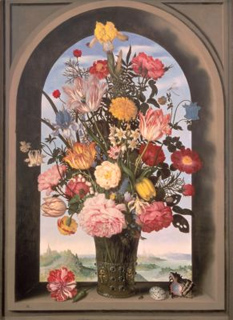During the four days of next week’s Chelsea Flower Show (23-26 May) the organisers expect to see around 170,000 visitors. Nevertheless it must be said that the love of flowers is not what it used to be.
Ambrosius Bosschaert the Elder’s Vase of Flowers in a Niche is a small (64 by 46cm) but uniquely transparent window on to a long-lost world of floral obsession. It was painted in 1620, when many now common-or-garden flowers such as tulips, hyacinths, anenomes and fritillaries were still exotic newcomers to Western Europe. Bosschaert shows us what some of the earliest European specimens of those flowers looked like. Just beneath the uncannily still surface of his picture we can, perhaps, sense the trembling excitement which their unfamiliar beauty once aroused.
In Holland, where Bosschaert lived and worked, the enthusiasm for exotic flowers was particularly strong. The tulip was imported by the botanist Carolus Clusius, who grew numerous varieties in his garden in Leiden, but its dissemination throughout the country is said to have been brought about by thieves who climbed over the fence one night and stole all his best bulbs. This was the first harbinger of what came to be known as the Dutch “tulipomania”, which the historian Simon Schama calls “the first great speculation crisis of modern capitalism”. At the height of this singular craze, the price of a single “Semper Augustus” bulb – producing a white flower flamed with red stripes, like the one in the bottom left of Bosschaert’s bouquet – rose to 13,000 guilders. To put that in perspective, a contemporary writer calculated that for a mere 2,500 guilders one could buy twenty-seven tons of wheat, fifty tons of rye, four fat oxen, eight fat pigs, twelve fat sheep, two hogsheads of wine, four tuns of beer, two tons...
Ambrosius Bosschaert the Elder’s Vase of Flowers in a Niche is a small (64 by 46cm) but uniquely transparent window on to a long-lost world of floral obsession. It was painted in 1620, when many now common-or-garden flowers such as tulips, hyacinths, anenomes and fritillaries were still exotic newcomers to Western Europe. Bosschaert shows us what some of the earliest European specimens of those flowers looked like. Just beneath the uncannily still surface of his picture we can, perhaps, sense the trembling excitement which their unfamiliar beauty once aroused.
In Holland, where Bosschaert lived and worked, the enthusiasm for exotic flowers was particularly strong. The tulip was imported by the botanist Carolus Clusius, who grew numerous varieties in his garden in Leiden, but its dissemination throughout the country is said to have been brought about by thieves who climbed over the fence one night and stole all his best bulbs. This was the first harbinger of what came to be known as the Dutch “tulipomania”, which the historian Simon Schama calls “the first great speculation crisis of modern capitalism”. At the height of this singular craze, the price of a single “Semper Augustus” bulb – producing a white flower flamed with red stripes, like the one in the bottom left of Bosschaert’s bouquet – rose to 13,000 guilders. To put that in perspective, a contemporary writer calculated that for a mere 2,500 guilders one could buy twenty-seven tons of wheat, fifty tons of rye, four fat oxen, eight fat pigs, twelve fat sheep, two hogsheads of wine, four tuns of beer, two tons...


